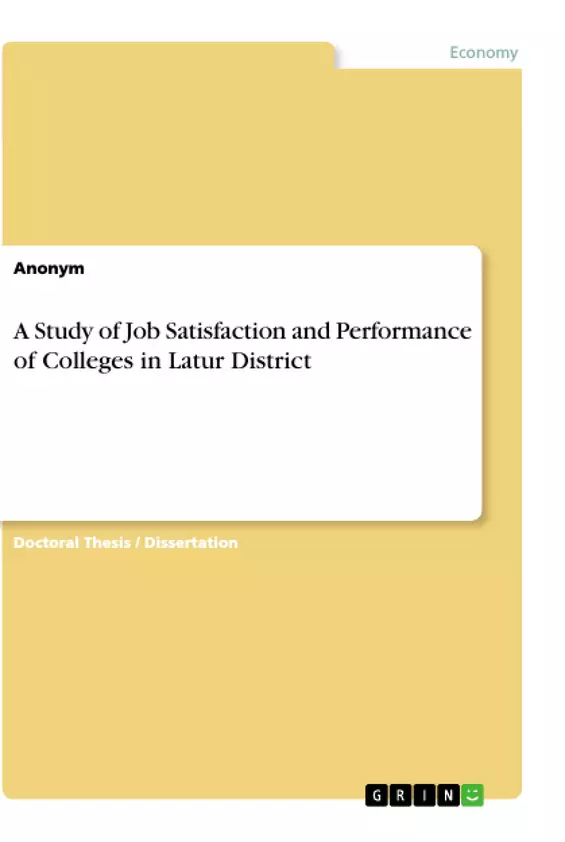The noblest profession in the world is Teacher. Today, many persons are found engaged in business concerns and perform their assigned jobs. Why they involve in the jobs? Off course to earn the money! Why money is to be earned? Money is to be earned to live the happy life. It means job and money are not ends but just means to accomplish the end i.e. happy life. It means the job or work is expected to contribute in their happy life and should become a prime source of their happiness and satisfaction. What is satisfaction? It can be described as; “state of pleasant feelings or perceptions is satisfaction”. If the job itself becomes cause to satisfaction, then this may be termed as job satisfaction.
Basically ‘satisfaction’ is a relative concept and varies from person to person. As it is cognitive phenomenon and it cannot be generalized in relation to all persons with any prescribed assumptions. Therefore, the objects of satisfaction differ from person to person. One more core element in satisfaction is, ‘it may not be in the external objects but depends upon personality traits’. One object may provide satisfaction to a particular person but the same object may not. Many times extremely opposite feeling can be perceived. Hence, This research have some unique objectives like : To understand different practices applied and services provided to HR and to know the extent of satisfaction in staff& its impact on their performance and to analyze growth and development of the staff on the basis of practices implemented by the college. This research concludes that Job satisfaction among teachers is ultimately impacting on student’s growth and development because a satisfied teacher can provide fruitful knowledge to the students. This study concludes that for accomplishment of institutional objective, there is need of satisfied workforce. Therefore, job satisfaction of teacher is the urge of the time. Significantly, job satisfaction and performance is very important to the continuing progress of educational institutes.
Inhaltsverzeichnis (Table of Contents)
- Chapter 1: Introduction
- 1.1: Meaning and Concept of Job Satisfaction
- 1.2: Review of Literature on Job Satisfaction
- 1.3: Review of Literature on Performance of Colleges
- 1.4: Statement of the Problem
- 1.5: Objectives of the Study
- 1.6: Research Hypothesis
- 1.7: Scope of the Study
- 1.8: Significance of the Study
- 1.9: Limitations of the Study
- 1.10: Methodology of the Study
- 1.11: Delimitation of the Study
- 1.12: Operational Definitions
- Chapter 2: Review of Literature
- 2.1: Review of Literature on Job Satisfaction
- 2.2: Review of Literature on Performance of Colleges
- 2.3: Review of Literature on Job Satisfaction and Performance of Colleges
- 2.4: Theoretical Framework
- Chapter 3: Research Methodology
- 3.1: Population of the Study
- 3.2: Sample Size and Sampling Technique
- 3.3: Data Collection
- 3.4: Tools of Data Collection
- 3.5: Data Analysis and Interpretation
- Chapter 4: Data Analysis and Interpretation
- 4.1: Analysis of Demographic Profile of Respondents
- 4.2: Analysis of Job Satisfaction of Teachers
- 4.3: Analysis of Performance of Colleges
- 4.4: Analysis of Relationship between Job Satisfaction and Performance of Colleges
- Chapter 5: Findings, Conclusions and Suggestions
Zielsetzung und Themenschwerpunkte (Objectives and Key Themes)
This thesis aims to understand the relationship between job satisfaction and performance of colleges in Latur district, Maharashtra, India. It explores the key factors that contribute to job satisfaction among teachers in these colleges and assesses their impact on overall institutional performance.
- Job satisfaction among teachers in Latur district colleges
- Performance of colleges in Latur district
- Factors influencing job satisfaction
- The relationship between job satisfaction and college performance
- Strategies for improving job satisfaction and college performance
Zusammenfassung der Kapitel (Chapter Summaries)
Chapter 1 introduces the study, defining job satisfaction and reviewing existing literature on job satisfaction and college performance. It outlines the research problem, objectives, hypotheses, scope, significance, limitations, methodology, delimitation, and operational definitions. Chapter 2 provides a comprehensive review of literature on job satisfaction, performance of colleges, and the relationship between them. It also presents the theoretical framework for the study. Chapter 3 details the research methodology, including population, sample size, sampling technique, data collection methods, tools, and analysis techniques. Chapter 4 analyzes the data collected, focusing on the demographic profile of respondents, job satisfaction levels of teachers, performance indicators of colleges, and the relationship between these two variables.
Schlüsselwörter (Keywords)
The primary focus of this thesis is on job satisfaction and performance of colleges in Latur district. Key terms include job satisfaction, performance, teachers, colleges, Latur district, factors influencing job satisfaction, relationship between job satisfaction and performance, and strategies for improvement.
- Quote paper
- Anonym (Author), 2019, A Study of Job Satisfaction and Performance of Colleges in Latur District, Munich, GRIN Verlag, https://www.grin.com/document/920624



